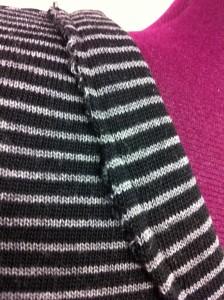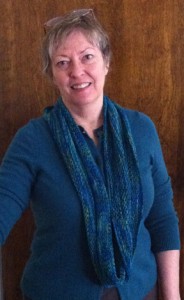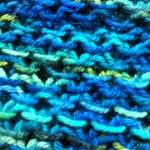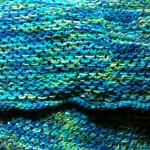 Pattern Description: T-shirt with interesting collar options and suggestions for mixing fabrics. Designed by Katherine Tilton
Pattern Description: T-shirt with interesting collar options and suggestions for mixing fabrics. Designed by Katherine Tilton
Sizing: XSM-SML-MED/LRG-XLG-XXL
Fabric Used: Purchased from MarcyTilton.com, it is now sold out and I am not positive about the fiber content. I believe it is rayon/lycra. It’s absolutely yummy with great stretch. The companion stripe has less stretch, so has to be cut accordingly. Marcy and her team frequently post “Cool Combos” – a yard or so of several fabrics that they like together. Kudos to the team, all of whom have great eyes for the mix!
Needle/Notions Used: Standard 10 or 12. A little 1″ strip of fusible knit interfacing to stay the shoulders.
Tips Used during Construction: I made this shirt during one of Marcy Tilton and Diane Ericson’s Design Outside the Lines workshops and was bulldozing my way through to get it done before the end of the workshop. It goes together quickly.
Did it look like the photo or drawing when you got through? Yes – considering my modifications.
How were the instructions? The only instructions I referred to were for the double collar. I changed these as noted below. Everything else was straightforward T-shirt construction. Shoulder, sleeves, neckline, side seams including sleeve, hems. Ta-daa.
Construction Notes: Collar – First, I skipped the references to zippers. (I didn’t have any zippers with me nor any way to get to a store in the available time.) Because of the weight/thickness of the fabrics, I offset the inner collar (the one next to my neck) to avoid having nine layers of fabric to sew through. I put the smaller collar (next to the body fabric) with its overlap at center front, then rotated the inner collar so that its overlap was just to one side of the overlap on the smaller collar. (This sounds confusing, but will make sense when you’re making the garment.)

Post-completion alterations: Fabric – I made one sleeve out of each of the two companion fabrics. (See first photo, above.) But when I put the shirt on and wore it a few times, I didn’t like it. The different sleeves—at least this combination on this shirt—just weren’t me. So I unsewed the right sleeve, cut a new one from the front body fabric, and now I love it! Cuff – The sleeve is cuffed. I’m not a fan of sleeve cuffs, but when I turn the cuff up to have the fold meet the seam – a 1¼” cuff instead of a 2½” cuff – I like it much better. I probably like it enough to cut the piece to that width next time. (See the picture to the left—which cuff do you like?) 
Body shape – I’m top-heavy (38D3, which measures about 42-43″ at fullest point). Based on measurements, I believed I needed to cut XLG. Wrong! I ended up taking extra wide seams and trimming shoulder in before attaching the sleeve. Next time I’ll cut a LRG. Once it was completed, I felt the top was too boxy, thus making me look bigger than I already am. I put a casing in the back and inserted some elastic. I like the look from the front much better, but will remove the casing and move it up a couple of inches to just below my bra strap. Oh, to have a sewing buddy to help me with fitting!! (I probably don’t need to confess to you that fitting is my nemesis.)
Likes/Dislikes: I love the interesting collar and adore the fabric! Will be making more of these.
Conclusion: This is another very good, flexible top from the sisters Tilton. You could make this top ten times and no one would recognize they’re all from the same pattern.

Oops! So glad I wrote this post and had the Jazzman take the pictures for me. Now I realize that the fabric on the back is thin enough for my black bra to show through. Won’t make that mistake again!
 Another of Marcy Tilton’s “Cool Combos” that came home from California with me was a bundle of gray and black stripes—one with the stripes about ¼ inch wide, one with narrower stripes, and one with sheer black stripes and abstract gray stripes.
Another of Marcy Tilton’s “Cool Combos” that came home from California with me was a bundle of gray and black stripes—one with the stripes about ¼ inch wide, one with narrower stripes, and one with sheer black stripes and abstract gray stripes. Laying the pattern pieces on the fabric to try to make the stripes meet on the side seams took me a long time. I need to figure out a better way to make sure the stripes are straight on the fabric. But my work paid off—I was very pleased with how they matched.
Laying the pattern pieces on the fabric to try to make the stripes meet on the side seams took me a long time. I need to figure out a better way to make sure the stripes are straight on the fabric. But my work paid off—I was very pleased with how they matched. But the part of this top that I am the most excited about is the binding on the neck opening. I had heard Marcy talk about this treatment, but had never tried it. I cut the binding strip along the selvedge, which had a rough, fringy edge. Instead of sewing it on the outside and wrapping to the inside, I sewed on the inside, wrapped to the outside, and topstitched a ¼ to an ⅛ inch from the selvedge edge. Because I’m working with a knit, I don’t have to worry about fraying. I have a decorative edge at no extra cost.
But the part of this top that I am the most excited about is the binding on the neck opening. I had heard Marcy talk about this treatment, but had never tried it. I cut the binding strip along the selvedge, which had a rough, fringy edge. Instead of sewing it on the outside and wrapping to the inside, I sewed on the inside, wrapped to the outside, and topstitched a ¼ to an ⅛ inch from the selvedge edge. Because I’m working with a knit, I don’t have to worry about fraying. I have a decorative edge at no extra cost.


















